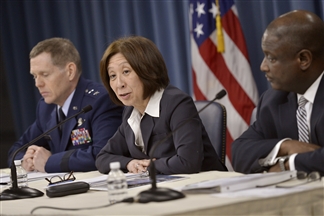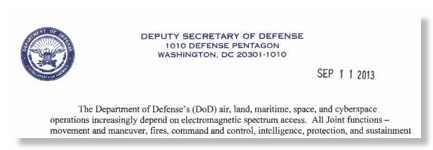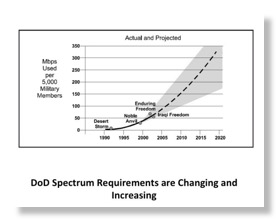DoD Electromagnetic Spectrum Strategy Release

Teri Takai, center, the Defense Department's chief information officer, Air Force Maj. Gen. Robert E. Wheeler, left, the department's deputy chief information officer, and Frederick J. Moorefield Jr., right, the department's director of spectrum policy and programs, brief reporters on the department's release of its electromagnetic spectrum strategy. DOD photo by Glenn Fawcett .
On Thursday February 20, 2014 “The Department of Defense announced … the release of its Electromagnetic Spectrum Strategy (EMS) to increase available spectrum in order to meet growing demand from the commercial wireless industry while maintaining critical military capabilities.” CTIA responded almost immediately with this statement from Steve Largent:
“We agree with the DoD's conclusion that its systems must become more spectrally efficient, flexible and adaptable. In fact, these are good goals for all federal users, and CTIA looks forward to engaging with the DoD, NTIA and the whole federal user community to see how the wireless industry can help them achieve their mission objectives while ensuring that commercial users have access to the spectrum our members need to meet consumer demand and drive economic growth and innovation.”
The first thing we noticed, sort of the “elephant in the room”, was that the report that was released was dated “SEP 11 2013”:

and was actually titled “Electromagnetic Spectrum Strategy 2013 - A Call to Action”. Why this 2013 report was released more than 3 months after it was signed and dated in an unclassified form is a mystery not mentioned in any trade press coverage. Our best guess was that there are a behind the scenes disagreement somewhere within in the Executive Branch or between FCC and NTIA. CTIA’s prompt response indicates that they were not waiting for the report to appear on the DoD website.
The following diagram from the report shows that DoD has a better handle on quantifying its needs than CTIA does with its famous “flag chart”: DoD quantifies its mobile communications needs in terms of “Mbps per 5000 Military Members” and shows how this has increase dramatically and will continue to do so. The cellular industry, by contrast, denominates its requirements solely in terms of MHz, independent of technical developments and the gains due to infrastructure growth/cell splitting. Now presumably the industry projection included expected gains from technical efficiency improvements and infrastructure growth, but these are never itemized nor are they updated. For example, due to the availability of new technology in the past 3 years, has the spectrum requirements in the “flag chart” increased or decreased? The real requirement for both DoD and the cellular industry is really denominated in data rate as DoD has done in this report. Kudos to DoD.
Getting to the actual report, it fully supports the reallocations ordered by President Obama in June 2010 to get 500 MHz of new spectrum to cellular carriers from existing federal and non-federal spectrum. No great surprise.
A key section says:
DoD systems must become more spectrally efficient, flexible, and adaptable, and DoD spectrum operations must become more agile in their ability to access spectrum in order to increase the options available to mission planners. (Spectrum efficiency is the use of the minimum amount of EMS resources necessary to ensure maximum operational effectiveness in fully accomplishing the required mission while taking all practicable steps to minimize impacts to other systems in the EME.Spectrum flexibility and adaptability is the capability of a spectrum-dependent system (SDS) to exploit various opportunities to access spectrum – e.g., multi-band operation, increasing the ability to share spectrum with other systems (domestic or foreign, federal, or non-federal), becoming more tolerant of interference. Agile spectrum operations will enable DoD systems to utilize their flexibility and adaptability to achieve mission success in rapidly changing EMEs.)
In the past, spectrum was a “free good” (except for minor NTIA regulatory fees) for DoD and other federal users and there was no incentive to be efficient as long as enough spectrum was obtainable. Top level attention to spectrum efficiency is thus a good move in the right direction and hopefully NTIA will extend this to other agencies. But the focus in this discussion is making military systems more agile so they can access more bands as they operate around the world.
What is missing is what NTIA Chief Larry Stickling said a few months ago, “sharing is the new normal”. While DoD is implementing White House orders to make spectrum available for the politically (and economically) powerful cellular industry, will DoD be more receptive to sharing proposals in other bands and be less likely to automatically stonewall? We have repeatedly pointed out that 225-400 MHz military use generally is very different geographically than civil use (San Diego being a notable exception) and that with new technology it could be made available to civil users on an “interruptible spectrum” basis, not unlike what is being considered for the 3550-3650 MHz band. Will DoD be receptive to such creative sharing proposals? We hope so but the new policy statement is silent on the issue.
We hope DoD and NTIA will clarify the issue of what is meant by “sharing is the new normal” and specifically whether this is a one way street with respect to military spectrum use in US territory.

Will spectrum sharing in US territory be a one way street for DoD?
UPDATE
See http://www.marcus-spectrum.com/Blog/files/SpecMeasCorr414.html




![Validate my RSS feed [Valid RSS]](valid-rss-rogers.png)

